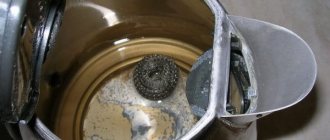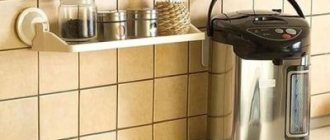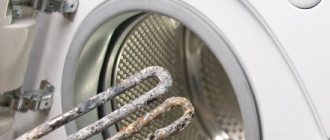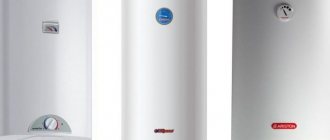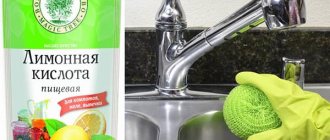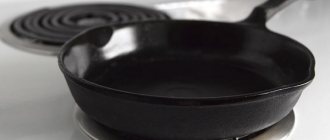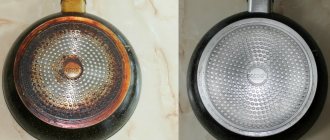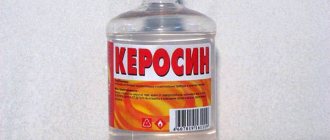Cleaning the kettle from scale is a mandatory procedure. Limescale periodically appears on the walls of all types of kettles, even those made from the highest quality materials.
Photo: Depositphotos.com. Author: photographee.eu
Water filters improve the situation a little, but even with them, scale continues to slowly appear.
One effective way to get rid of it is to clean the kettle with soda. This substance is available and sold in any grocery store, and does an excellent job of removing harmful plaque.
What is scale in a kettle and how does it affect the human body?
The scale layer in the kettle is a deposit of limestone and heavy metals that are in the water. Even if filtered and purified water is used, there are still lime particles left in it, which are deposited on the heating elements of the equipment. Very often, after prolonged use of kitchen utensils, a whitish coating forms on the walls, which is scale deposits.
It needs to be removed as soon as possible. This is done so that dense formations do not interfere with the operation of the heating elements. Due to the thick layer, heating elements cannot contact water directly, so they require more voltage and overheating, which is why they can fail.
Getting a large amount of this cruel garbage into the body along with drinking water is fraught with bad consequences for the body. All this debris, like stones, can be deposited in the liver, kidneys and bile ducts, causing urolithiasis.
How to prevent limescale deposits
The occurrence of deposits cannot be completely prevented . They only try to prevent the appearance of a hard and thick layer, since it is much more difficult to deal with.
Regular cleaning significantly extends the service life of utensils : in ordinary kettles the enamel is not destroyed, and the heating elements of electrical appliances do not overheat. Cleaning reduces gas and electricity costs, as water boils faster due to improved thermal conductivity of the walls and heating elements.
Important! For preventive purposes, the resulting plaque is removed every 2-3 weeks. The thick layer does not grow during this time, so cleaning takes much less effort.
To reduce scale formation:
- Only boil filtered water.
- At night, the liquid from the kettle is drained into another container.
- The water is not boiled again. This significantly slows down the process of salt deposition on the surface.
- The kettle is rinsed after each boiling.
- Try to wash the inner surface daily with a regular sponge.
Soda for descaling the kettle
This is an excellent substance that helps clean any surfaces from deposits, including scale from kitchen utensils. It is sodium bicarbonate or sodium bicarbonate, which is an abrasive.
Properties of soda
Thanks to the abrasive effect, you can clean any surface without damaging the container itself. Also, soda powder or its solution can affect the hardest deposits in different parts of the dishes.
It is also an antiseptic teapot cleaner, so it will remove any bacteria that may be in the containers.
The powder does not cause allergies and is safe, even if it enters the body in small quantities.
Order of conduct
The usual procedure is carried out by boiling a soda solution. To do this, fill the container with water, add one or two tablespoons of soda, and boil. After the liquid has cooled slightly, it will need to be poured out, and the remaining scale can be easily removed with a sponge.
Features when cleaning different types of teapots
Regardless of what type of equipment (an electric kettle or a regular one for a gas stove), the procedure for removing accumulated sediment at home is carried out using almost identical methods.
But it's important to note a couple of differences:
- It is recommended to boil the electric kettle several times and turn it off after adding the soda solution. In this way, it will be possible to maximize the impact of carbonic acid on sediment accumulations on the bottom and walls. And quickly descale your electric kettle without using chemicals.
- When an ordinary aluminum kettle with soda solution boils, it should not be immediately removed from the stove. You need to leave it for at least another half hour. This will help the reaction intensify and it will be much easier to get rid of the scale.
After removing the coating, the dishes need to be thoroughly rinsed and boiled (preferably several times). And only after this can you use the water to prepare drinks.
Recipes with soda
When choosing anti-scale products for different types of materials, you need to understand that some surfaces will react negatively to strong abrasives or dyes, so you should also pay attention to the material.
This is what regular baking soda looks like.
Regular soda
Soda without any impurities can be used for metal and enameled, including electrical appliances. And if these are ordinary kettles, then pour a little soda into them for a full kettle of water and boil this mixture over low heat for 15-20 minutes so that all deposits dissolve. If it is an electric kettle, then it is filled, boiled, and then left to cool completely. If necessary, repeat the procedure. Most of the grains of limescale will pour out along with the water, and the remaining will be soft and can be easily removed with a soft sponge.
Soda with salt
Salt is also an abrasive substance, so it is used as an additional agent. The cleaning procedure is the same. For a kettle of water you need a spoonful of soda and a spoonful of salt. If you reduce the concentration by half, you can periodically carry out preventive cleaning in this way.
Salt and citric acid
Almost any kettle, including a plastic one, can be cleaned with salt and citric acid. For a full container you need 2 teaspoons of citric acid and one teaspoon of soda. After boiling, leave the mixture to cool and then descaling will be much easier.
Soda, salt and citric acid.
Another option for the same procedure is to boil water with citric acid, and then wipe the surface covered with plaque with a sponge and soda. The acid will soften the deposits, and cleaning with baking soda will remove them completely.
Soda and vinegar
Using the same principle, cleaning is carried out using soda and vinegar. These two substances are placed in a kettle and brought to a boil, then left to cool completely. All deposits become soft and can be easily removed with a regular sponge.
Soda, lemon and vinegar
This process requires quite a lot of time, but it is effective even on the oldest scale deposits. First of all, you need to boil a full kettle of water with a spoonful of soda and pour out the liquid. The second time, you need to pour a spoonful of citric acid into clean water, boil and pour out. The third time you need to boil water in a kettle with the addition of half a glass of vinegar.
After this, you can clean the kettle of deposits and boil clean water again to remove the smell.
Soda Ash
Instead of baking soda, you can use soda ash. It is no less effective, but it will need to be rinsed well so that it does not enter the human body. After cleaning with this type of soda, you need to clean the kettle several times with clean water.
Instead of regular soda, you can use soda ash.
General recommendations
In order to avoid the appearance of a large amount of scale, you need to carry out preventive boiling with one spoon of soda every week. This method does not take much time, but it is effective and will help maintain the health of the teapots and significantly extend its service life.
Useful tips
Dense scale deposits that have formed over time can be difficult to clean. They do not dissolve completely and scratch the surface of the kettle when trying to remove them.
There are several recommendations that will allow you to forget about harmful deposits and extend the life of the kettle:
- use special filters to clean and reduce water hardness;
- do not keep the water in the kettle constantly, but pour it into another container as it cools;
- Rinse the kettle daily under normal water;
- Clean the surface of the kettle once a week with regular soda.
Methods for cleaning a kettle with soda are among the most gentle. This substance does not damage the surface of the dishes, and when it gets into drinking water it is harmless to humans. In addition, soda is no less effective than most store-bought products, while it compares favorably in cost.
Recipes with additional ingredients may not be equally beneficial for different teapots. Before using them, you should make sure that they will not damage the surface.
Features depending on material
It must be borne in mind that some methods have disadvantages: they are not applicable to all types of materials. Thus, hard scrapers and abrasives are not suitable for delicate surfaces.
Enameled surface
Enamel teapots are easy to clean in almost any way. However, you should not use too hard grains or metal brushes, which can damage the enamel of the kettle’s surface.
Electrical
When cleaning electric kitchen tools, you will need to fill them with water, then pour in the required amount of substances that will be used to clean them, and boil.
An example of an electric kettle.
Usually, for the drug to work more effectively, you will need to repeat boiling several times or leave the water with soda until it cools completely.
Stainless steel
Stainless steel teapots are quite durable. However, it must be borne in mind that they should not use too harsh abrasives or harmful chemicals.
Ceramics
Ceramic kitchen utensils are not afraid of cleaning with soda, but are afraid of substances that can stain a light surface
Glass
Glass teapots are quite stable and do not require any additional care. But when cleaning them, you need to be careful not to scratch the glass bulb itself.
Teapot with glass flask.
How often should deposits be removed?
Regular cleaning will help prevent excessive limescale build-up.
The surfaces of a glass teapot need to be cleaned at least once every seven days (tiny particles of limescale are visible on the transparent walls). Monthly cleaning will help keep metal or ceramic teapots clean.
The frequency of cleaning is affected by the quality of the water used . By pouring bottled or well-filtered water into dishes, you can reduce the number of cleanings to a minimum.
Other methods for cleaning a kettle
In addition to these listed methods, there are a number of other methods that are used to clean teapots.
These include:
- carbonated drinks like Fanta, Cola, Pepsi and Sprite. And even mineral water, due to the soda content in its composition, is excellent;
- Fruit and vegetable peelings, due to the acid content in the composition, will help cope with plaque. They must be washed well, placed inside the dishes and boiled;
- chemicals that are created specifically for cleaning scale also quickly remove plaque. However, they are dangerous to the body.
It should be understood that after using any cleaning methods, the kettle must be washed as thoroughly as possible. In some cases, it will take several boils of clean water to remove the smell of all substances.
Why does it work
Arina Piskareva
Laboratory employee of the Department of Bioengineering, Moscow State University
Scale is mainly composed of calcium and magnesium carbonate. When interacting with citric, acetic, orthophosphoric or other acid, sparingly soluble carbonates of alkaline earth metals are converted into readily soluble salts. For example, acetates. Therefore, acidic substances are effective in the fight against scale, and to enhance the reaction they need to be heated.
Soda, when interacting with water, produces carbonic acid molecules, which, in turn, react with insoluble calcium and magnesium carbonates, turning them into soluble bicarbonates. And they are easily washed off with water and removed with a sponge.
Apple peel
It is better to pay attention to cleaning with apple peel. You need to choose the sour varieties of fruit, fill the peeled peel with water and cook everything in a kettle for about an hour.
The method is suitable for enameled and metal teapots with a weak layer of scale.
Not suitable for electric kettles.
You will need:
- ½ liter of water;
- skin of 2-3 potatoes, apples or pears.
Rinse the cleaning from dirt and sand, put them in a kettle and fill with water. Boil the liquid and leave to steep for one to two hours. A light layer of scale will come off on its own; rub stubborn stains with a dishwashing sponge. After rinsing, the kettle will shine like new.
We suggest you familiarize yourself with How and what to boil laundry
If you have a particularly spacious kettle, and scale has accumulated on the walls, take more water than indicated in the recipes. The liquid should cover the dirt completely.
Brine
- Suitable for any teapots.
- Proportions: the kettle must be filled ¾ full.
- Pros: simplicity, accessibility.
- Cons: does not cope with persistent plaque, specific smell.
The brine contains lactic and acetic acids. Fill the kettle with strained cucumber or tomato brine and boil for 20–30 minutes.
After this, drain the brine and scale and wash the kettle with a soft sponge and cleaning agent.
If you want to try some non-standard method, you can use cucumber pickle for boiling. Without preliminary dilution, it is poured into the kettle and boiled for an hour or two. Sometimes the brine is replaced by whey or sour milk, but the smell in this case leaves much to be desired.
